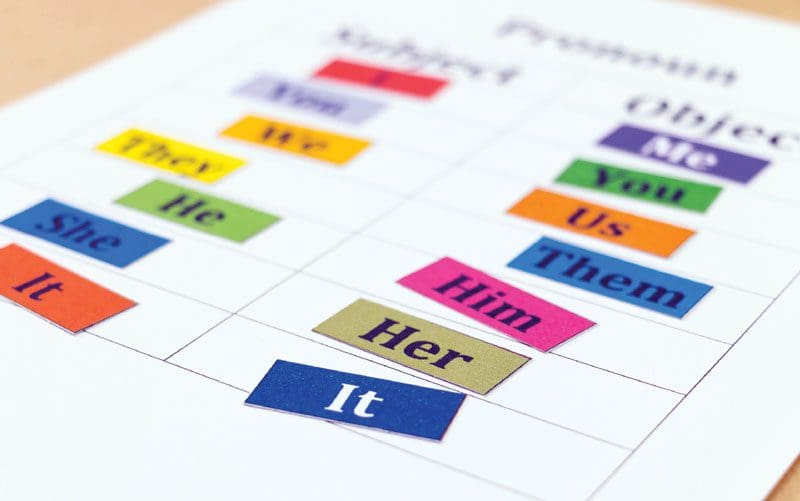
Unlocking Spanish Pronouns
Unlocking Spanish Pronouns. There is a key rule for reading Spanish: DO NOT try to translate word for word in your head. Instinctively, you will want to, but it’s not a good idea. Invariably, you’ll find yourself in the middle of a sentence completely baffled. That’s because English and Spanish sentences don’t have the same structure; the words are in a different order. To overcome this Spanish learning challenge, you should read each sentence in your head as a whole. Pick out the words you know and allow your mind to logically put them together. Until your mind is trained to do these sentence translation calisthenics automatically, resist the urge to translate one word at a time.
The structure changes when you start replacing the object nouns with pronouns by placing them before the verb.
Understanding Object Pronouns
Also try not to slam the page shut on this grammar talk and crawl into a fetal position waiting until it stops. Bear with me for a moment as I try to make it as painless as possible.
By “it,” I’m referring to little words just like it in Spanish right before the verb … that until now you’ve just avoided and pretended don’t exist. How cool would it be to simply say the word “it” like in English? Think about it … how do you say “it” in Spanish? Such an important little word, so let’s deal with it. Please follow me into pronoun town.
By simple definition, a pronoun takes the place of a noun. Spanish pronoun town has many different inhabitants. We will focus on a trio of pronouns that are a bit troublesome.
Lo, La and Le
They might sound like the chorus of a quaint 1980s song, but they are pronouns. They take the place of nouns in a sentence that answer the questions “what?” (direct object) or “to whom?” (indirect object).
Example:
The boy gives the ball to the dog.
What does the boy give?
the ball (direct object noun) = it
(direct object pronoun)
To whom does he give it?
the dog (indirect object noun) = him
(indirect object pronoun)
In English, we simply replace the nouns with the pronouns and keep on trucking: The boy gives it to him. In Spanish, it’s trickier. The base sentence has the same structure as in English: El chico da la pelota al perro (The boy gives the ball to the dog). However, the structure changes when you start replacing the object nouns with pronouns by placing them before the verb.
In Spanish, the ball is la pelota (direct object noun). For the direct object pronoun (it), we drop pelota but keep la: El chico la da al perro.
If the direct object noun you are replacing is masculine, the it pronoun becomes lo. Example: El chico da el palo (the stick) al perro = El chico lo da al perro.
Using our original sentence, El chico da la pelota al perro (The boy gives the ball to the dog), let’s explore the Spanish le as the indirect object pronoun (it) replacing al perro (the dog):
The boy gives the ball to him = El chico le da la pelota.
Note: the indirect object pronoun le can be translated as to him or to her, regardless of whether the noun being replaced is masculine or feminine.
Now, if you are still with me, prepare to have your mind blown. To say The boy gives it to him, here’s what happens: El chico se la da. Le becomes se whenever it precedes lo or la, but only when they are together.
If you haven’t already gone off to pour yourself a stiff drink, I leave you with this advice for reading in Spanish: those pronouns you see before the verb (me, te, se, le, lo, la, nos, los, las or les) are receiving the action. Jump over them, figure out what the verb is doing and then swing back to see who or what the action is aimed at. As suggested before, read the full sentence first, start working with the words you know and let your brain figure out the structure.
Pondering Pronouns
Yo doy el palo al perro.
I give the stick to the dog
Lo doy al perro.
I give it to the dog.
Le doy el palo.
I give him the stick.
Se lo doy.
I give it to him.
Spanish Pronunciations: Vowels and Consonants
Spanish – Great minds think alike
Spanish – A dash of Pura Vida
Spanish – Step up your game
Spanish – Leveling Up, the 20/90 Challenge
Spanish- Tips for a New Year of Language Learning
Spanish – Relax, Engage, Learn
Spanish – Banter, a pura vida life skill
Spanish – Here’s looking at you, kid
Spanish – Yearning for Learning
Spanish – Seven Motivating Reasons to Start Learning today
Spanish – Verbs to live by
Spanish – Beware of false friends
Breaking the barriers of learning Spanish
